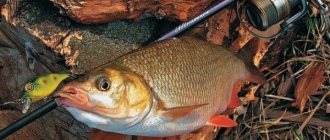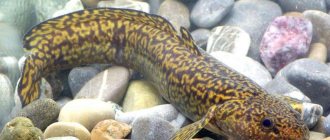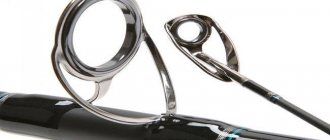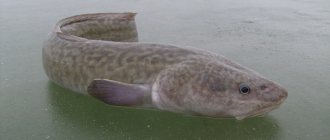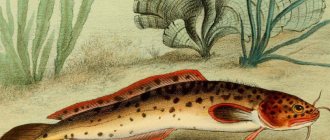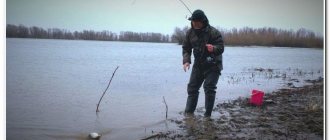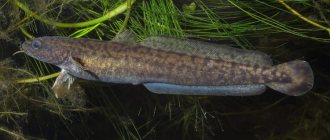Burbot is the most unusual representative of the ichthyofauna. It differs from other types of fish not only in appearance, but also in its lifestyle. In good weather, almost all underwater inhabitants are active, but he does not manifest himself in any way. But in bad weather, when you don’t want to go outside, let alone fishing, the handsome spotted creature “wakes up,” comes out of its hiding place and begins to feed intensively. It's the same in winter. If the sun is shining, there is no wind and the thermometer is plus, it is extremely difficult to catch burbot. But a blizzard, frost and a pitch-black sky are what you need to catch burbot in winter.
Burbot is a predator that prefers to hunt mainly in the dark. Like the catfish, it is the orderly of the reservoir, so you can catch it with both live fish and dead fish or pieces of fish meat. The gear used for catching burbot in winter varies from a simple winter fishing rod to a girder. If you do not take into account weather conditions, such winter fishing at first glance seems like a simple activity, but in fact, not every ice fishing enthusiast can catch burbot in winter. To do this, you at least need to know its habits and habitats.
Behavior of the fished object during the cold period
In November, this fish begins to eat, which continues until mid-winter. In January, activity decreases as burbots begin to spawn.
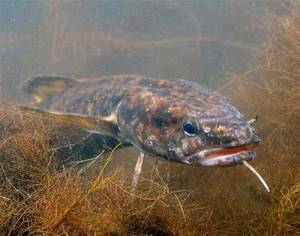
During spawning, they are caught much worse than at the beginning of the season, but this does not mean that a trip to the river will necessarily be unsuccessful. A couple of specimens can be caught even during the period of mass spawning.
Having spawned, the burbot gradually recovers, becomes active again, and bites on everything that fishermen offer it. This lasts until about mid-spring, and then the predator lies down in the pits and remains in a half-asleep state until late autumn. This is why catching burbot in winter is the best period, especially the first and last months.
Burbot habitats
The cold-loving burbot does not tolerate warm water well, so in the summer it looks for areas with cooler water. In rivers it can move to the upper reaches, and in lakes and reservoirs it enters bottom holes or hides under stones in shaded, steep places near the shore. The presence of bottom springs is also a good sign of the presence of burbot. The water temperature in such areas differs significantly. This is noticeable during summer swimming even in a shallow (2-5 m) lake. If, while searching for a place to catch burbot, a silted bottom is discovered, then you should continue to search for a more promising place. It is usually located in areas with rocky and pebble bottom surfaces.
Where to look for a predator
Burbot is found in deep rivers and lakes with clear water. He is very demanding of his habitat; polluted areas within the city are definitely not for him. There are two ways to determine its presence in a reservoir: ask local fishermen or take depth measurements and make a map. If there are a lot of places with serious depths (10, 12, 15 meters), then there is no doubt that there is burbot here, and it sits out the hot summer in them. Another reference point will be the ruffs. The more there are, the higher the probability of the presence of the target, because spiny bottom fish are his favorite delicacy.
Burbot in shallow water
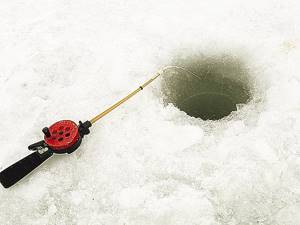
Photo by Anatoly Mailkov
Until the moment when the ice breaks away from the shore, catching burbot in shallow places, usually near the shore, can be very interesting. The advisability of hunting for burbot during this period of spring lies in the fact that you can fish not only at night, but also during daylight hours, which, you see, is somewhat more pleasant. Night fishing is very romantic, but sitting on the ice under the spring sun is not only more pleasant, but also calmer.
A rather monotonous picture is now observed on reservoirs. The small perch, which stay near the shore all winter, are joined by medium-sized fish that come from deep places. Deep perch occupy water near the shore edge with a depth of one to three meters. It is quite likely that there are roaches walking between the schools of perch and moving quickly. And flocks of spawning ruffe come to the shallowest places near the shoreline. It is characteristic that in those places near the shore where there is a ruff, the perch stands a little deeper. Such areas can be tied to underwater spits, to a flooded forest, and on a large reservoir it may happen that there is no characteristic change in either the coastline or depths. It happens that you walk along the shore over a depth of one to one and a half meters and in some completely unremarkable place you come across a school of fish. If you move further, then again the area without fish begins, but in some place it appears again. Now it is completely useless to hope that the fish will walk along the shore and stumble upon bait. You need to find the fish, that is, first find the perch, and most importantly, the ruff. It has been noticed that it is the ruff that now attracts the burbot, which approaches and stands next to the perch at the same depth and at the same distance from the coastal edge.
Well, if there is a sufficient amount of ruff in the reservoir, then finding it is not so difficult. But ruff populations experience obvious fluctuations in numbers from year to year, and quite significant ones at that. Periodically, this fish is “attacked by pestilence” and it takes several years to restore the stock. Can't find the ruff. Then you need to look for pike. The hunting grounds of burbot and pike throughout the winter very often coincide. It’s not for nothing that the common tactics of fishing with girders have proven themselves to be quite good, in which during the day the live bait swims in the water column, and at night the weight and bait are placed on the bottom.
The tactics for catching burbot in the absence of ruff are proven and simple, especially in those areas where fish forms the basis of the diet of local residents. This is work. The point is to arrange as much gear as you can manage. This could be a hundred deliveries per fisherman. You need to catch live bait, make holes, arrange gear. During the day you need to check these gears. It’s another matter when there are a lot of ruff and it comes right to the shore. In such a situation, burbot hunts specifically for ruff. Fishing can become very exciting if you give up baiting and move on to active search and fishing with live bait using bottom equipment.
There are options here on what to choose as a live bait carrier. This could be a jig head or a large jig. Not even necessarily large, but heavy. And a spinner. A ruff can be hooked onto a jig hook in different ways - by the lip, by the back, by the tail, which depends on both the tackle and the fishing technique. I personally think that it is more effective to hook the bait on the back near the tail, so that the ruffe walks over a large area. By selecting a jig by weight, it is easy to limit or expand the area over which the baitfish moves. You can attach live bait or cut bait to a jig head and play by tapping on the bottom exactly as they do during the pre-spawn run of burbot in January. But now burbot does not have a clear path along which it migrates during the pre-spawning and post-spawning periods. Now the burbots are distributed in a flock in ambushes over a fairly large area under the school of perch. Therefore, you not only have to make many holes, but also try to expand the search using moving live bait.
It is worth noting that the hunt for individual burbots is now underway. It is very rare that you can catch more than two fish from one hole.
If for one reason or another it is difficult to make many holes or the space on the ice for searching is limited, it makes sense to switch to a spinner, but it is better to do this when there has been at least one bite on a jig. It is noteworthy that the spinner should be noisy, rattling, knocking, as you like, that is, produce a powerful dull sound that spreads over many meters. To do this, you can, for example, attach a “eared” weight to the upper winding ring of the spinner. The point of this design is only that when the bait touches the bottom it makes a clear sound. In this case, fishing tactics become significantly more sedentary. That is, you can sit over one hole and tap the bait on the bottom, in the hope that the burbot will become interested, come up and be tempted by the ruff on the hook. It is difficult to predict how long to wait, since burbot can become active both at nine in the morning and at two in the afternoon.
Now is the time when, if you don’t want to go out on the ice on a large body of water, you can catch burbot in a river where the ice has melted, but the flood has not yet arrived. The water has risen somewhat, but it is still clear and the current is not strong. The best days come when the ice has broken out and the water has subsided a little.
On an open river you need to look for places where small fish accumulate. Often such places are visible from the bleak, since both roach and gudgeon usually stand under it. It must be taken into account that small fish stick to some places during the day and others at night. It is very difficult to predict the time of a predator's approach to the bait. It has been noticed that burbot, like large pike, is better caught in weather when fish of other species prefer not to be active. That is, at a change in weather, in the rain, during strong winds. But on a full moon, on a clear, quiet night, there will most likely be no bites. Although I had a case when a burbot pecked after lunch in a completely clear sky from clouds during the full moon.
The gear is not elegant. As a rule, these are very simple in design equipment for fishing with bait lying on the bottom. Construct several “tricks” based on fishing line with a diameter of 0.3-0.5 mm, with a sliding sinker. Below the weight, tie or attach a leash made of fishing line with a diameter of 0.25-0.3 mm with a single hook No. 1-3. The tee will contribute to the “dead” hooks of the tackle. Watching burbot bites is not at all necessary, although it is quite interesting. You can cast a donk and check it every half hour: if the burbot bites, it will simply swallow the bait and wait to be pulled ashore. But it must be said that when pulled out, the burbot resists quite strongly and stubbornly, trying to catch its tail on some obstacle. The bite is very reminiscent of the ruff “twitching” of a jig in winter or the summer bite of rotan. These are precisely the twitchings that can result in a classic stretch.
Small live bait is used as bait, attached to a hook by the lip. I consider the best live bait to be ruffe and gudgeon, that is, those fish that lead a bottom lifestyle, although burbot often prefers small perch or even bleak. I see literary advice that the ruff’s spines should be cut off or its scales scraped off as not only inhumane, but also ineffective.
Based on where the first bites occur, it makes sense to adjust all other gear to the distance and depth. But if after some time the bites stop, you need to look for another level. In the event that the first fish was caught while reaching the shallows, it is better to arrange the equipment along the area of the shallows or underwater spit, since the next bite can occur at any point in the selected area, and it is almost impossible to predict it. That is, the tactics for catching burbot are continuous search and waiting. Echo sounders are not very helpful, since burbot literally crawls along the bottom with long stops. Another thing is that with the help of an echo sounder it is easier to detect the hard and rocky bottom that this fish loves so much. And, of course, hidden from view, stones, branches and tree trunks lying at the bottom.
Andrey Yanshevsky March 27, 2015 at 04:17
What gear should I use?
The choice of gear for winter burbot fishing is unlimited. Winter donks, fishing rods with a heavy jig, spinner or balancer, knockers, and girders are used. With the right approach, they are all effective, especially if the process occurs at night. Let's take a closer look at each of them.
Donka
You can't think of anything simpler than this gear. They consist of a reel, thick fishing line (0.4-0.5 mm), a sinker that can withstand the current, a leash up to 25 cm long installed above it and a large hook (No. 8-12). Coarse rigs do not frighten burbot, so there is no need to use thin fishing line and risk losing the rig. You shouldn’t bother with the length of the leash either. After grabbing, this predator does not rush to the side, as the pike does, it swallows its prey right on the spot.
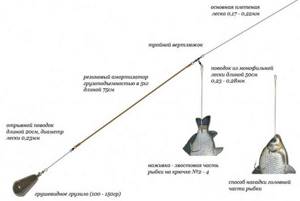
Bottom equipment
When fishing for burbot on a bottom in winter, the bait is either live bait or pieces of fish. Bird offal is also often mentioned in fishing literature, but such bait is not aesthetically pleasing and creates some inconvenience. It is much easier to attach a minnow or a pipe cleaner to a hook; besides, a live fish on the bottom will behave restlessly and thereby attract a predator.
Donks are installed so that the reel lies across the hole. This tackle shows the best results if you put it on in the evening and check it in the morning. On a crowded body of water, it is advisable to cover the donk with snow, otherwise the prey may go to competitors.
Spinner and balancer
To fish with artificial bait, you will need a durable winter spinning rod equipped with an inertial reel with a stopper and a supply of fishing line that allows you to fish at decent depths. A variety of spinners and balancers are used for winter fishing: zander, pike, homemade ones made taking into account the preferences of burbot, balancers of all types and sizes. For the latter, it is advisable to remove the lower tee, if it is provided by the manufacturer, otherwise it may alert a predator. There is no need to be afraid of gatherings; the handsome spotted guy almost always swallows greedily and deeply.
Fishing for burbot in winter
In winter, burbot is caught using girders (from the bottom) and lures, while burbot also bite during the day. A wide variety of spoons are used as bait, on which you can attach dead fish, worms, chicken skin and other animal bait. The principle is similar to fishing for rotan, with the only difference that no sharp jerks are required, but you need to play literally at the bottom and on the bottom. We caught burbot without a spoon at all, lowering a regular jig sinker into the hole, onto which we mounted a tee using a winding ring. But a piece of fish was already placed on the tee.
As they say, we talked about burbot only superficially; there are also subtleties in catching it. For example, when fishing, you need to have a supply of leashes in advance so that you don’t have to fiddle with tying a hook at night. The tackle is simply cut off (the hook sometimes remains in the burbot, you can remove it at home), and a ready-made leash is mounted; you will find all the most interesting things about the burbot just below.
Actually, if you managed to catch a good burbot, in terms of cooking, dishes made from it will not leave anyone indifferent. Try it, good luck and all the best.
Share with your friends!
Alternative attachments
In winter, especially in inclement weather, it can be difficult to get live bait, but this is not the only food for burbot. Experienced burbot fishing enthusiasts have been harvesting worms since the fall; many breed them in basements and garages. This activity does not involve any tangible costs; you just need to find a wooden box on the farm and fill it with compost mixed with soil. If you throw fifty worms there at the beginning of autumn, they will multiply and by winter form a large colony. In addition, fattening burbot can be caught well on amphipods, store-bought sprat (not salted), and any meat, even spoiled ones.
Fishing tactics
Burbot is not a perch that you have to chase all over the pond. When going on such fishing, the angler must know exactly where he is located or be able to quickly determine them. This is the main thing, everything else is a matter of technique.
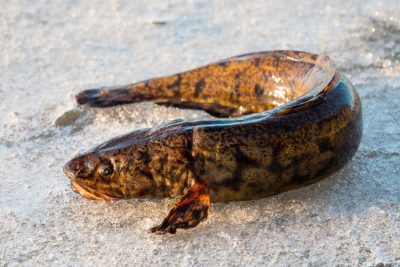
Donks, girders and baits are mainly set up at night, but during the day you can try to catch burbot using a spoon or a snooker. It happens that it begins to become more active in the late afternoon, when it is already getting dark. It’s a shame to go home empty-handed, and even with the knowledge that the bite is just beginning. To avoid getting into such a situation, you should always carry a tent, a burner, a reliable flashlight and provisions with you. Video on the topic:
Winter Fishing Super Cool (burbot on a winter fishing rod)
01:10:27
Catching burbot at night in the dead of winter using a spoon in a vertical line.
25:52
BURBT for PEREMET
09:30
narybalke
Winter fishing for burbot
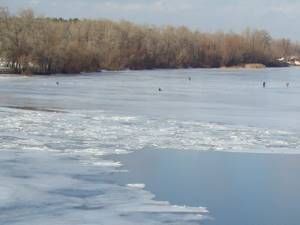
Catching burbot from ice
Winter is the golden time for burbot fishing. The fish behaves as actively as possible, responding to natural baits and artificial baits. On rivers where the predator is found in abundance, the most popular fishing method is vertical trolling for burbot from the ice.
You can catch burbot in winter both during the day and at night. At night, it is mainly experienced fishermen who go out on the ice, who know the water area well and know how to fish in the absence of lighting. The results are usually impressive.
In the daytime, it is better to go out for burbot in cloudy weather. The first step is to fish dumps, edges, pits, depressions, and various shelters where you can hide. The predator does not like to stand in open areas, so it is enough to make a couple of “duty” postings and you need to move on.
In some regions, burbot is caught using sprat. The store purchases fresh frozen or fresh fish, which are placed on an open jig head of the required weight in a pond. Posting such bait is carried out in the same way as feeding a spinner. The only thing that should be taken into account is the duration of the pauses, which are recommended to be increased.
Burbot feeds on exits, so it happens that at a promising place you have to wait a long time for bites. Then the fish becomes active and within half an hour you can earn several bites and take a couple of weighty “tails”. Then the grip of the bait stops, as if there was no one in the water.
Burbot on the girders
Zherlitsy are considered a very productive direction for fishing for burbot in winter. It is customary to install traps for burbot in the evening and leave them overnight. Check the gear in the morning. Often another night “vagrant” pike perch may also be hooked.
Place the tackle at promising points. For example, several holes are distributed throughout the pit itself, the remaining holes are drilled at the entrance, exit, and side slopes. If there are shelters in the form of flooded old snags, boulders and other things, then they definitely need to be fished, since here the probability of a bite is high.
On a winter night, the thermometer drops low. The holes quickly set, the fishing line freezes tightly in them, there is no way to get away from this. Therefore, in the morning, a fresh hole is drilled near the evening hole, the fishing line is hooked with a hook and the tackle is checked.
Catching burbot on girders is passive winter fishing, which does not have a sporting component. Therefore, active “penguins” who prefer dynamic fishing methods will not like this direction. But in terms of efficiency, such production may well surpass vertical trolling.
